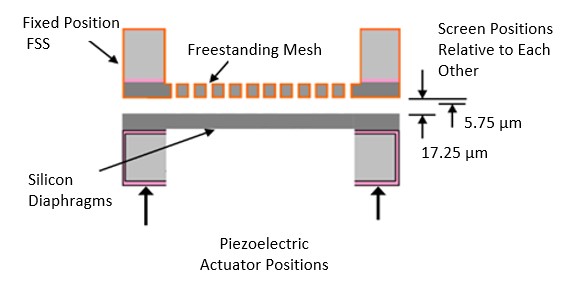Lead Organisation: Queen’s University Belfast
Project Lead: Raymond Dickie
This project undertook the development of an electronically reconfigurable Frequency Selective Surface (FSS) technology to provide a means to switch between scene radiation and on-board calibration targets (OBCT’s) in remote sensing radiometers. A new concept has been devised to reduce the demands imposed or even replace the mechanical systems currently used for hot and cold radiometric calibration.
Two different methods for reconfiguring the FSS switch were investigated, one using liquid crystal material and the other piezoelectric actuators. Both methods have the potential to provide low insertion loss, wide bandwidth and high switching speed. A preliminary numerical analysis was made for both methods operating in the frequency range 250 – 350 GHz. The predicted insertion loss of liquid crystal based switches was found to be between 0.6 – 1 dB with a minimum channel isolation of 12 dB over a 10 GHz bandwidth. For the piezoelectric device the results were better and a 0.3 – 0.65 dB insertion loss and isolation of more than 15 dB was obtained. The piezo actuated method was therefore baselined for further study and a detailed design was carried out over 294 – 305.5 GHz, a frequency range that covers molecular emissions of N2O, O3, and O2.


The spectral transmission response exhibited by the piezo actuated FSS is shown in the figure (top). With a 17.25 μm separation, the signal transmits through the structure with very little loss (dashed line). By reducing the physical separation to 5.75 μm, the wave transmission is significantly reduced and therefore most of the energy is reflected (solid line). A section view of the piezo operated device is also shown in the figure (bottom).
The reconfigurable FSS architecture was manufactured using 10 µm thick silicon material due to its intrinsic high yield strength and high relative permittivity, both providing desirable respective structural and electrical properties. In addition this material is space qualified.
Electrical characterisation using swept frequency transmission measurements were carried out using an ABmm 100 – 700 GHz vector network analyser in conjunction with a purpose build quasi optical test bench. The FSS mesh was measured over the frequency range 310-345 GHz, and the agreement with the numerical predictions was found to be excellent in terms of the position of the 323 GHz resonant frequency and insertion loss of 0.3 dB.
This project has advanced significantly the concept for replacing motor driven hot and cold radiometric calibration systems with an all-electronic solution. Numerical simulations have been used to demonstrate that a satisfactory electromagnetic performance is obtained, and one option based on a piezoelectric system was baselined as the preferred option for further study. Spectral transmission measurements for the individual building block of the electronic switch, a single layer FSS, are shown to be in excellent agreement with numerical simulations.
